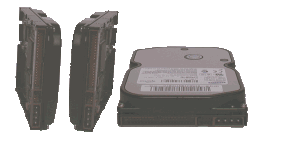The recent development of hard-disks capacity has really been
breath taking. I can still remember a couple of years back an article
in a scientific journal pointing out
that the laws of physics would limit the capacity of harddisks.
The size of the magnetic regions in ferro magnetic materials have
a fixed size and can therefore not shrink for ever.
Surprisingly the harddisk manufactures have found ways to make them
smaller. 80 GB disks are nothing unusual.
But what will we do with all that space?
Well the answer is easy. Have you
ever looked at the size of an executable called netscape?
14MB for 4.7X and the trend is growing. Netscape 6 is sooo big and
slow that it only runs with acceptable speed on very recent hardware.
Why must a web browser include a news reader, a mail
application, java-vm etc... all in one big executable?
In the hope to get rid of browser bugs you upgrade to the new version and
at the same time you get a new mail reader. The old mail reader was
always working perfectly while the new one does not.
Where are the skilled software engineers that used to produce
beautiful stable, small and fast applications?
Gnome has recognized this and made a lot of wind
by announcing
its new component model, Bonobo. KDE has not made that much noise,
but meanwhile it was using the time to implement it and hopefully
KDE 2.0 will be ready soon.
Still, where is a fast and stable browser that will still rung in the future,
even on my Pentium 200?
Are text-only browsers like
w3m
and lynx the only stable and slim
alternative? Some ongoing projects want to produce such a browser. viewml will be a browser for small embedded
systems. It uses the html rendering engine from the KDE project (kfm). At the
moment it is still under development and even more unstable than netscape
4.7, but it might become a very nice browser. An other alternative is galeon. It is based on the new
mozilla engine Gecko. This browser is as well at an early stage but works
already quite well. You will however need the new harddisk to install 24MB of
mostly unused mozilla code ;-).
 REBOL the rebel
, by Georges Tarbouriech
REBOL the rebel
, by Georges Tarbouriech MagicPoint
, by Charles Vidal
MagicPoint
, by Charles Vidal  Approaching Vector Linux
, by Sujan Swearingen
Approaching Vector Linux
, by Sujan Swearingen  How to report bugs on Debian 2.2?
, by Egon Willighagen
How to report bugs on Debian 2.2?
, by Egon Willighagen Bastille-Linux
, by Frédéric Raynal
Bastille-Linux
, by Frédéric Raynal  Building Scalable ISPs with open-source software
, by Atif Ghaffar
Building Scalable ISPs with open-source software
, by Atif Ghaffar  Slackware 7.0 part I: Installation Guide
, by Jeffry Degrande
Slackware 7.0 part I: Installation Guide
, by Jeffry Degrande  Book review: Professional PHP Programming
, by John Perr
Book review: Professional PHP Programming
, by John Perr How do I install a new harddisk? Plugging in the cables
is usually not a big thing as they are clearly labeled and
fit normally only in one direction.
The bearings of harddisks are not made to hold the spinning disks in
every position. Unfortunately this is normally not
described in the manual or leaflet that comes with the disk.
If you insert it the wrong way into the computer then you will see
it fading away after a couple of months.
You may insert the disk as shown in the first picture:

This is either standing on the long small side or facing the
printed circuit board _down_ (!!).
You should never mount it with the metal side down and the printed circuit board up like this:

| © 2000
LinuxFocus Go to the LinuxFocus Contact Person Page |